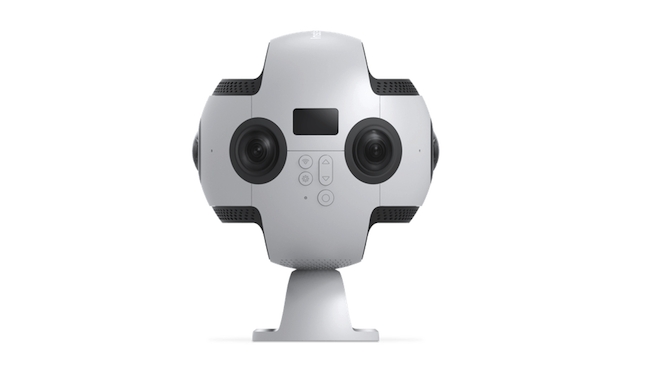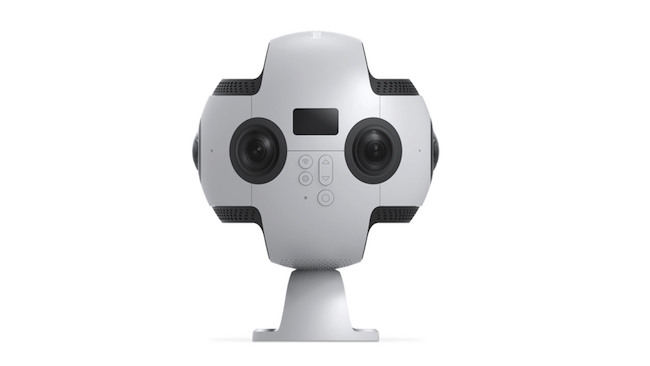
 The Insta360 Pro: truly powerful, but truly pro?
The Insta360 Pro: truly powerful, but truly pro?
There are clear gaps in the market for affordable, professional 360-degree cameras. Did CES 2017 come close to plugging any of them? Matt Aindow reports.
Happy New Year RSN readers! What better way to start 2017 than to rummage through press releases leaving the Nevada desert last week. Bold statements are expected at CES, the world’s biggest consumer technology expo, and whilst the tech media jostle at the trough, manufacturers take the opportunity to launch their latest and greatest solutions. If 360 feels peripheral to you right now, I’m betting that 2017 will be the year that it pings on everyones Sonar. So, as creative content producers (pro or folk), we have many questions to ask and answer about the nature of story telling in this new space. But believe, it isn’t going away, and the effects will touch every department of our current production/post ecosystem. As producers we should be exploring every opportunity to monetise VR/360, because VR will have an important role to play not just in entertainment, but also in communications, work, and learning, indeed in every aspect of our lives.
The Insta360 Pro
First to register on the scope is Insta360. The manufacturer, Shenzhen Arashi Vision Co. Ltd, already has a firm foothold in the 360° video space with products such as the award winning Nano, designed to clip on to the iPhone. Enter the Insta360 Pro. This product claims to raise the bar for professional VR imaging with 8K resolution, 3D image and video capturing, plus immersive advanced livestreaming capabilities.
Liu Jingkang, Insta360 CEO and founder said, “Insta360's most advanced technology comes together in the Insta360 Pro, the most powerful, all-in-one VR and 3D content capture solution”. The emphasis here, and the reason RedShark is talking about it, is the inclusion of Pro in the product’s title. Hmm. Why launch at a consumer show? Well, with a price set at around the $3000 mark, this is a disruptive salvo into the space currently occupied by GoPro’s Omni (a 6 camera rig costing around $5000). So with nothing from GoPro on the show floor it was a very smart move to make a bid for that space.
Before we take a closer look at the Insta360 Pro, other note-worthy 360° cameras on display were also focusing on that consumer arena: the Ricoh R, Polaroid Pop and Vuze 3D 360 all jostling for the same piece of (small) pie. The question they’re addressing is this, ‘If you already own a VR headset, perhaps you want to create your own 360 content?’ It’s early doors, but that’s what these manufacturers are banking on.
Standalone end-to-end solution
So, back to the Insta360 Pro. Until very recently, the options for 360 video production were essentially based around a RED or GoPro solution. Other companies have dipped a toe into the water, providing one or more parts of the jigsaw, but early adoption has been a Heath Robinson affair; building rigs to house existing cameras and the crazy post pipeline has been challenging.
If Insta360 can deliver on the hype, there is a growing number of 360 content producers desperately looking for a useable camera that doesn’t require a heavy workflow commitment or huge up-front investment. Has Insta360 hit the sweet spot?
Scrolling through the product page impressive claims abound, but is there any substance to the use of the term ‘ground-breaking’ or is it CES hyperbole? As a SMPTE man, the way 4K and 8K are here tossed about with gay abandon to mean several different things at once triggers a twitch on my left temple. My suspicions are confirmed as I read line after line of sound bites without substance. For a camera claiming a Pro pedigree, things we are not told include sensor resolution, size, type, dynamic range, base colour temp, sensitivity… I could go on. It’s a soon-to-be-released launch so perhaps we can only expect vague news at this stage, but let’s consider anyway the more interesting claims about the spec and stats.
Roses and thorns
I was most impressed by the image stabalisation demonstrated on the test footage. They claim to have developed an algorithm that offers seamless image stitching using optical flow technology. However, I’m counting only two on-camera microphones and this is a shame. It suggests that ambisonics, a key part of the immersive experience, has been relegated to a third party solution — the user. We are helpfully informed that we can connect an external mic.
For live-broadcasting, a key driver of 360 adoption, the Insta360 Pro will live-stream 4K video “to any 360-degree live streaming platform...” live streaming of events (and non-events alike) in 360 is becoming ever more popular with Facebook, YouTube and Twitter all supporting the format. Similarly, although 3D TV may have been consigned to the tech dustbin, what we learned from that doomed experiment has been resurrected and applied to stereoscopic 360; the holy grail of immersive video. This could be the masterstroke for Insta360 Pro. The blurb claims to be offering ‘professional 3D 360-degree video up to 6K (4K in real-time stitching mode), by applying the same 3D video capturing capabilities as Hollywood films’, but unfortunately it doesn’t then expand on which technology is actually used.
The Insta360 Pro, using 6 independent, high-definition lenses, captures 60-megapixel 360° 3D stills and up to 8K 360° videos. When recording in 4K video mode, the camera supports up to 100fps.
With support for both HDR and RAW formats, early feedback from trusted sources out in Las Vegas is positive, claiming impressive levels of detail and low-light performance. However, stating the combined stitched image resolution as 8K (7680*3840@30fps – post processed) or the 3D stills res as 60-megapixels doesn’t tell us enough about the 6 sensors involved, except that they are perhaps lower than the 2K x 2K used in the sensor arrays of other Pro 360° video cameras such as the OZO. Perhaps the emphasis on 8K can be dismissed as marketing blurb, helping to differentiate it from the company’s own line of 4K consumer cameras. The processing power required to stitch & render in realtime means that there’s a difference between the spatial and temporal resolutions to which you have access. Post processing gives you the highest quality output, but do we get access to the raw data? And there’s no mention of the hardware processing requirements.
Since some of the specs are thin on information and pose more questions than they answer, I will hold off on my judgment. The proof of the pudding was ever in the eating, but I have to say I’m excited at the potential and promise offered by this product. More when we get our hands on one.
Tags: VR & AR


Comments